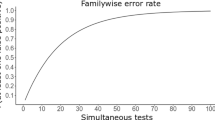Abstract
As environmental monitoring data are collected successively in time, the data are suitable for sequential analysis. An earlier article proposed a refined sequential probability ratio test (SPRT) to test against a minimal relevanttrend, assuming no serial correlations and without modeling the spatial covariance matrix. As the model parameters are unknown in advance, a minimal number of observations(n min) is required for estimation prior to analysis. Leaving the spatial covariance matrix unstructured, n min increases if the number of sampling locations increases. Therefore, assumptions on the spatial covariance matrix are proposed, thereby reducing the number of nuisance parameters, thus reducingn min. This article studies. three simple types of spatial covariance matrix structures and derives an adjusted SPRT for each of these types. Furthermore, we examine the robustness against deviations from the assumed spatial covariance matrix structure. Simulation studies show that adjusted SPRTs can be derived rather easily and that they are in general robust against deviations from the assumed type of spatial covariance matrix. Sequential analysis of simulated data, which are based on monitoring data of bats in the Netherlands, illustrates the use of one of the derived SPRTs.
Similar content being viewed by others
References
Brillinger, D. R. (1994), “Trend Analysis: Time Series and Point Process Problems,” Environmetrics, 5, 1–19.
Dutilleul, P., and Pinel-Alloul, B. (1996), “A Double Multivariate Model for Statistical Analysis of Spatio-Temporal Environmental Data,” Environmetrics, 7, 551–565.
Eisenberg, B., and Ghosh, B. K. (1991), “The Sequential Probability Ratio Test,” in Handbook of Sequential Analysis, eds. B. K. Ghosh and B. Eisenberg, New York: Marcel Dekker, pp. 47–65.
El-Shaarawi, A. H. (1993), “Environmental Monitoring, Assessment and Prediction of Change,” Environmentrics, 4, 381–398.
Li, K. H., Nhu, D. L., Sun, L., and Zidek, J. V. (1999), “Spatial-Temporal Models for Ambient Hourly PM10 in Vancouver,” Environmetrics, 10, 321–338.
Meijers, E. M. J. (1986), “Defining Confusions—Confusing Definitions,” Environmental Monitoring and Assessment, 7, 157–159.
Schipper, M. (1999), “Towards a Sequential Analysis of Environmental Monitoring Data,” un published PhD thesis, Leiden University.
Schipper, M., Den Hartog, J., and Meelis, E. (1997), “Sequential Analysis of Monitoring Data: Optimal SPRTs,” Environmetrics, 8, 29–41.
Schipper, M., and Meelis, E. (1997), “Sequential Analysis of Monitoring Data: Refined SPRTs for Testing Against a Minimal Relevant Trend,” The Journal of Agricultural, Biological, and Environmental Statistics, 2, 467–489.
Siegmund, D. 1985, “The Sequential Probability Ratio Test,” in Sequential Analysis: Test and Confidence Intervals, New York: Springer-Verlag, pp. 8–33.
Ter Keurs, W. J., and Meelis, E. (1986), “Monitoring the Biotic Aspects of Our Environment as a Policy Instrument,” Environmental Monitoring and Assessment, 7, 161–168.
Van der Tweel, I., and Van Noord, P. A. H. (2000), “Sequential Analysis of Matched Dichotomous Data from Prospective Case-Control Studies,” Statistics in Medicine, 19, 3449–3464.
Vos, P., Orleans, A. B. M., Meelis, E., and Ter Keurs, W. J. (1991), “Meetnetten voor het natuur-en milieubeleid. Een systematiek vooropzet en gebruik (Monitoring systems for environmental policy. Systematics for design and usage),” Landschap, 8, 249–263 (in Dutch with English summary).
Wald, A. (1947), Sequential Analysis, New York: Wiley.
Wetherill, G. B., and Glazebrook, K. D. (1986), Sequential Methods in Statistics (3rd ed.), London: Chapman and Hall.
Whitehead, J. (1997), The Design and Analysis of Sequential Clinical Trials (revised second edition), Colchester: Wiley.
Author information
Authors and Affiliations
Corresponding author
Rights and permissions
About this article
Cite this article
Schipper, M., Meelis, E. Making sequential analysis of environmental monitoring data feasible by simplifying the covariance matrix structure. JABES 8, 122–137 (2003). https://doi.org/10.1198/1085711031238
Received:
Revised:
Issue Date:
DOI: https://doi.org/10.1198/1085711031238




